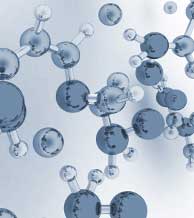N-ACETYLNEURAMINIC ACID ALDOLASE from Microorganism
NAL-301
N-Acetylneuraminate pyruvate-lyase(EC 4.1.3.3)¹ ˜⁴⁾
N-Acetylneuraminate ⇆ N-Acetyl-D-mannosamine + Pyruvate
| Appearance: | Yellowish amorphous powder, lyophilized |
|---|---|
| Activity: | Grade III 15U/mg-solid or more (30U/mg-protein or more) (containing approx. 30% of stabilizers) |
| Contaminants: | Catalase ≤1.0% NADH oxidase ≤1.0x10⁻³% |
| Stabilizers: | Mannitol, EDTA |
| Stability: | Stable at -20°C for at least One year (Fig.1) |
|---|---|
| Molecular weight: | approx. 98,000 |
| Isoelectric point: | 4.6±0.1 |
| Michaelis constant: | 2.5×10⁻³M (N-Acetylneuraminic acid) |
| Structure: | 3 subunits (approx. 35,000) per enzyme molecule |
| Inhibitors: | p-Chloromercuribenzoate, SDS, Hg⁺⁺, Ag⁺ |
| Optimum pH: | 7.5-8.0 (Fig.3) |
| Optimum temperature: | 70°C (Fig.4) |
| pH Stability: | pH 6.0−9.0 (10°C, 25hr) (Fig.5) |
| Thermal stability: | below 65°C (pH 7.5, 30min) (Fig.6) |
| Effect of various chemicals: | (Table 1) |
APPLICATIONS
This enzyme is useful for enzymatic determination of N-acetylneuraminic acid and sialic acid
when coupled with the related enzymes in clinical analysis. ⁵˜⁷⁾
For industrial use, this enzyme is useful for enzymatic synthesis of sialic acid.⁸˜⁹⁾
ASSAY
Principle:
N-Acetylneuraminic acid aldolase
N-Acetylneuraminate ► Pyruvate+ N-Acetyl-D-mannosamine
lactate dehydrogenase
Pyruvate+NADH+H⁺ ► L-Lactate+NAD⁺
The disappearance of NADH is measured at 340 nm by spectrophotometry.
Unit definition:
One unit causes the oxidation of one micromole of NADH per minute under the conditions described below.
Method:
| A. NANA solution: | 50mM [Dissolve 309mg of N-acetylneuraminic acid (MW=309) in ca. 15ml of 50mM K-phosphate buffer, pH 7.5 and, after adjusting the pH to 7.5 with 1N KOH, fill up to 20ml with the same buffer.] (Stable for at least one week if stored at 0- 5°C) |
|---|---|
| B. LDH solution: | approx. 50U/ml[Dilute pig heart lactate dehydrogenase (Toyobo GradeII, ammonium sulfate suspension) to a concentration of approx. 50U/ml with ice-cold 50mM K-phosphate buffer, pH 7.5] (Should be freshly prepared) |
| C. NADH solution: | 1.0mM [Dissolve 7.6mg of NADH・Na₂・3H₂O (MW=763) in 10ml of 50mM K- phosphate buffer, pH 7.5] (Should be freshly prepared) |
| D. Buffer solution: | 50mM K-phosphate buffer, pH 7.5 |
| E. Enzyme diluent: | 50mM K-phosphate buffer, pH 7.5 containing 0.2% BSA |
Procedure
| Concentration in assay mixture | |
|---|---|
| K-Phosphate buffer | 50 mM |
| NANA | 20 mM |
| NADH | 0.2mM |
| LDH | ca.10 U/ml |
1. Prepare the following reaction mixture in a cuvette (d=1.0cm) and equilibrate at 37C˚for about 5 minutes.
1.0ml Substrate solution (A)
0.5ml LDH solution (B)
0.5ml NADH solution (C)
0.4ml Buffer solution (D)
2. Add 0.1ml of the enzyme solution* and mix by gentle inversion.
3. Record the decrease in optical density at 340nm against water for 3 to 4 minutes in spectrophotometer
thermostated at 37C°, and calculate the ΔOD per minute from the initial linear portion of the curve (ΔOD
test).
At the same time, measure the blank rate (ΔOD blank) using the same method the test except that the
enzyme diluent (E) is added instead of the enzyme solution.
* Dissolve the enzyme preparation in ice-cold enzyme diluent (E) and dilute to 0.1-0.3U/ml with the same buffer, immediately before assay.
Calculation
Activity can be calculated by using the following formula:

ΔOD/min (ΔOD test-ΔOD blank)×Vt×df
Volume activity (U/ml) = = ΔOD/min×4.02×df
6.22×1.0×Vs
Weight activity (U/mg) = (U/ml)×1/C
- Vt
- : Total volume (2.5ml)
- Vs
- : Sample volume (0.1ml)
- 6.22
- : Millimolar extinction coefficient of NADH (cm²/micromole)
- 1.0
- : Light path length (cm)
- df
- : Dilution factor
- C
- : Enzyme concentration in dissolution (c mg/ml)
REFERENCES
- D.G.Comb and S.Roseman; J.Biol.Chem., 235, 2529 (1960).
- D.G.Comb and S.Roseman; Meth.Enzymol., 5, 391 (1960).
- S.B.Arden, W.Chang and L.Barksdale; J.Bacteriol., 112, 1260 (1972).
- Y.Uchida, Y.Tsukada and T.Sugimori; Agric.Biol.Chem., 49, 181 (1985).
- P.Burunetti, A.Swanson and S.Roseman; Meth.Enzymol., 6, 465 (1963).
- K.Taniuchi, Y.Miyamoto, Y.Uchida, K.Chifu, M.Mukai, N.Yamaguchi, Y.Tsukada, T.Sugimori, K.Doi and S.Baba; J.Med.Technol. (Japanese), 7, 403 (1979).
- K.Sugahara, K.Sugimoto, O.Nomura and T.Usui; Clin.Chim.Acta, 108, 493 (1980).
- Mahn-Joo Kim,William J.Hennen,H.Marcel Sweers and Chi-Huey Wong; J.Am.Chem.Soc.,110, 6481 (1988).
- Ethan S.Simon,Mark D.Bednarski,and George M.Whitesides; J.Am.Chem.Soc.,110, 7159 (1988).
| Chemical | Concn.(mM) | Residual activity(%) |
Chemical | Concn.(mM) | Residual activity(%) |
|---|---|---|---|---|---|
| None | − | 100 | PCMB | 2.0 |
0% |
| Metal salt | 2.0 | NEM | 2.0 |
103 |
|
| MgCl₂ | 107 | NaF | 2.0 | 100 | |
| CaCl₂ | 87 | NaN₃ | 20 | 100 | |
| Ba(OAc)₂ | 95 | EDTA | 5.0 | 95 | |
| FeCl₃ | 89 | o-Phenanthroline | 2.0 | 100 | |
| CoCl₂ | 93 | α,α'-Dipyridyl | 2.0 | 101 | |
| MnCl₂ | 98 | Borate | 50 | 86 | |
| ZnSO₄ | 92 | Triton X-100 | 0.10% | 109 | |
| NiCl₂ | 99 | Na-cholate | 0.10% | 95 | |
| CuSO₄ | 64 | SDS | 0.10% | 0 | |
| Pb(OAc)₂ | 87 | Tween 40 | 0.10% | 96 | |
| AgNO₃ | 0 | Span 85 | 0.10% | 93 | |
| HgCl₂ | 0 |
Ac, CH₃CO; PCMB, p-Chloromercuribenzoate; NEM, N-Ethylmaleimide, EDTA, Ethylenediaminetetraacetate; SDS, Sodium dodecyl sulfate.






To get a quote, contact us at info@toyobousa.com, or INQUIRY.